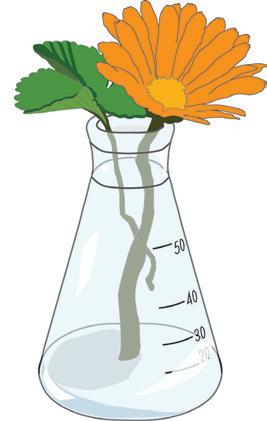
5 minute read
Under the Spotlight: Environmental Science
Environmental Science classes provide an oppourtunity for students to learn about the world outside
by: MALLORY SWOPE staff writer
Advertisement
Students in Ian McGurn’s Environmental Science class during the 2018/2019 school year were given the opportunity to further their learning of ecological relationships by building aquaponic systems. They spent weeks working to perfect the habitats that host both plant and animal life preparing to display their projects for all of CHS to see. All was going well as they started putting them up section by section, and it was time to commence the final step: running water through the system. “They completely stopped working and flooded the hallway,” McGurn said. While other aspects of the class might come across as more difficult than others, Environmental Science, as well as some new extensions of the course, can provide students with educational yet unique experiences. TCAPS requires high school students to earn a minimum of three credits in the science department prior to graduation, of which Biology and either Physics or Chemistry are non-negotiable. CHS offers a number of different courses that can fill the place of that third credit outside of the classes predetermined by upperlevel administrators, including: AP Biology or AP Chemistry, Anatomy and Physiology, Biomedical Science, Environmental Science, and a new offering to CHS this year, AP Environmental Science. In the 2018-2019 TCAPS Course Selection Guide, Environmental science courses are described as “[integrating] major branches of science: life, physical, chemical and earth, with environmental topics to provide students with a scientific knowledge of our planet earth, its many interconnected systems, and the ways in which human activities affect it.” Lisa Johnson began teaching Environmental Science at CHS for the first time this school year. “I was actually the teacher who requested we bring AP Environmental Science (APES) to CHS because I felt there
was a gap in the curriculum we offered for students who wanted to learn more about Environmental Science” Johnson explained. Halfway into the first semester, she remains excited for what the future holds. Johnson recognized that students taking APES this year “have been amazing and are motivated to succeed.” Perhaps a reason for their motivation is the hands-on aspect and the structure that the class offers. The class follows a very similar structure everyday that relates back to its acronym; they begin with an Audit (A) or review of which module students completed the previous night followed by Practice (P) whether it be math problems or something based on the homework, and they wrap up the module with some form of Exercise (E). The exercises range from labs to modeling activities to off-campus field trips, but they last several class periods most of the time. Johnson’s students had the opportunity to go to Oakwood Cemetery this fall to collect data that applied toward a study the class was conducting about human survivorship and the population history in Traverse City. “One of the best things about APES is that every single topic applies to the world outside CHS,” Johnson described, “so far this year we’ve investigated questions such as how much energy can you save with a new refrigerator, and how does having a green lawn affect biodiversity, and how do forests reestablish after a fire?” Emma Corrado ‘22 is interested in furthering her education post-high school to one day become an environmental lawyer. She saw APES as a gateway class into this potential career. She is also fond of the level of organization of the class. “In general the way Ms. Johnson teaches the class and how she sets up our assignments to apply the content [to the outside world] makes the class very interesting and easier to learn the content,” Corrado said. However, the class does not come without its challenges. Corrado explained that the class grade depends heavily on test performance, so ensuring an understanding, if not mastery, of the content is extremely important for success in the class. APES is unique in the sense that it’s a “flipped classroom” according to Corrado; “Notes are

done at home then assignments in class. We start the class with going over a module that was supposed to be outlined the night before,” she said. Corrado has discovered the organization outlined by Johnson to be true in its predictability, but continues to be surprised by the interest she has for learning the content. Corrado advises students interested in taking APES next school year to “pay attention in class and take detailed outlines.” This targeted group of students should be encouraged to take the class, in Corrado’s opinion, “to become more aware of how everything in life has a relationship with the environment.” McGurn has taught regular Environmental Science at various points in time throughout his eleven year teaching career, but he began teaching it at CHS specifically during the 2018/2019 school year. McGurn has found Environmental Science classes to cause some frustration among his students due to the broadness of the content. “We cover such a wide variety of things, it gives students the ability to really like some of it, but maybe not all of it,” he suggested. Also parallel to APES is the structure regular Environmental Science classes have to offer. McGurn’s students expect to come into class each day to an introduction through the form of a thoughtprovoking question followed up with some sort of activity that expands on the introduction or a topic previously studied. Despite the broadness of each topic, they all relate back to the environment and its entirety. Environmental Science really focuses on two questions: How did the Earth get here and how do humans impact the environment? “The content we teach directly relates to our environment and how we interact with it. It [the content] is the world outside,” McGurn declared. While some students might view Environmental Science classes as being, as McGurn put it, “a catch-all class because they have to take a science credit,” others enjoy the structure and the opportunity to absorb skills that will support them in life and science classes to come. Regardless of the extent of difficulty AP and regular Environmental Science automatically hold, each respective class is challenging in its own regards. However, as Johnson stated, “[Environmental Science] is a course where students learn to view the environment around them in a more comprehensive way and are engaged in finding solutions to environmental problems facing their generation.” //









